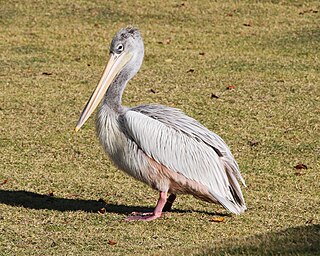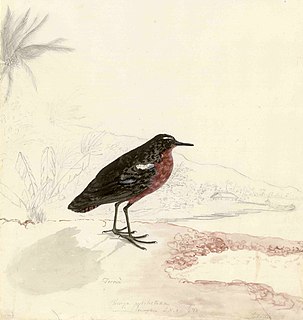
The ruddy duck is a duck from North America and one of the stiff-tailed ducks. The genus name is derived from Ancient Greek oxus, "sharp", and oura, "tail", and jamaicensis is "from Jamaica".

The Australian pied cormorant, also known as the pied cormorant, pied shag, or great pied cormorant, is a medium-sized member of the cormorant family. It is found around the coasts of Australasia. In New Zealand, it is usually known either as the pied shag or by its Māori name of kāruhiruhi. Older sources may refer to it as the "yellow-faced cormorant".

The pink-backed pelican is a bird of the pelican family. It is a resident breeder in the swamps and shallow lakes of Africa and southern Arabia; it has also apparently extirpated in Madagascar.

The cinnamon bittern or chestnut bittern is a small Old World bittern, breeding in tropical and subtropical Asia from India east to China and Indonesia. It is mainly resident, but some northern birds migrate short distances.

The yellow bittern is a small bittern. It is of Old World origins, breeding in the northern Indian Subcontinent, east to the Russian Far East, Japan and Indonesia. It is mainly resident, but some northern birds migrate short distances. It has been recorded as a vagrant in Alaska and there is a single sighting in Great Britain, from Radipole Lake, Dorset on November 23, 1962 – however, the British Ornithologists' Union has always considered this occurrence to be of uncertain provenance and currently it is not accepted onto the official British List.

The reed cormorant, also known as the long-tailed cormorant, is a bird in the cormorant family Phalacrocoracidae. It breeds in much of Africa south of the Sahara, and Madagascar. It is resident but undertakes some seasonal movements.

The watercock is a waterbird in the rail and crake family, Rallidae that is widely distributed across Southeast Asia. It is the only member of the genus Gallicrex.

The vinaceous dove is a bird species in the pigeon family Columbidae that widely resident across the Sahel and Sudan (region).

The South African shelduck or Cape shelduck is a species of shelduck, a group of large goose-like birds which are part of the bird family Anatidae, which also includes the swans, geese and ducks. This is a common species native to southern Africa.

The Tahiti sandpiper or Tahitian sandpiper is an extinct member of the large wader family Scolopacidae that was endemic to Tahiti in French Polynesia.

The red-faced cormorant, red-faced shag or violet shag, is a bird species of the family Phalacrocoracidae.

The rock shag, also known as the Magellanic cormorant, is a marine cormorant found around the southernmost coasts of South America. Its breeding range is from around Valdivia, Chile, south to Cape Horn and Tierra del Fuego, and north to Punta Tombo in Argentina. In winter it is seen further north, with individuals reaching as far as Santiago, Chile on the west coast and Uruguay on the east. The birds also breed around the coasts of the Falkland Islands.
The Phoenix petrel is a medium-sized tropical seabird, measuring up to 35 cm (1.15 ft) long, with a wingspan of 83 cm (2.72 ft). It has a dark brown upperparts plumage, white below and whitish throat. The sexes are similar.

The African rail is a small wetland bird of the rail family that is found in eastern and southern Africa.

Leucocarbo is a genus of birds in the family Phalacrocoracidae with the members commonly known as blue-eyed shags. This is a group of closely related cormorant taxa. Many have a blue, purple or red ring around the eye ; other shared features are white underparts and pink feet.

The snowy sheathbill, also known as the greater sheathbill, pale-faced sheathbill, and paddy, is one of two species of sheathbill. It is usually found on the ground. It is the only land bird native to the Antarctic continent.

The zigzag heron is a species of heron in the family Ardeidae, also including egrets and bitterns. It is in the monotypic genus Zebrilus. It is found in Bolivia, Brazil, Colombia, Ecuador, French Guiana, Guyana, Peru, Suriname, and Venezuela. Its natural habitat is subtropical or tropical swamps.
The Polynesian storm petrel is a species of seabird in the family Oceanitidae. It is the only species placed in the genus Nesofregetta.

The large-billed tern is a species of tern in the family Laridae. It is placed the monotypic genus Phaetusa. It is found in most of South America. It has occurred as a vagrant in Aruba, Bermuda, Cuba, Panama and the United States. Its natural habitats are rivers and freshwater lakes.

The Christmas sandpiper or Kiritimati sandpiper was a small shorebird. It became extinct some time in the first half of the 19th century. It was endemic to Christmas Island, since 1919 part of Kiribati. It is known solely from a single contemporaneous illustration, and a description by William Anderson, both made during the third circumnavigation voyage commanded by Captain James Cook, which visited the atoll of Christmas Island between 24 December 1777 and 2 January 1778.





















